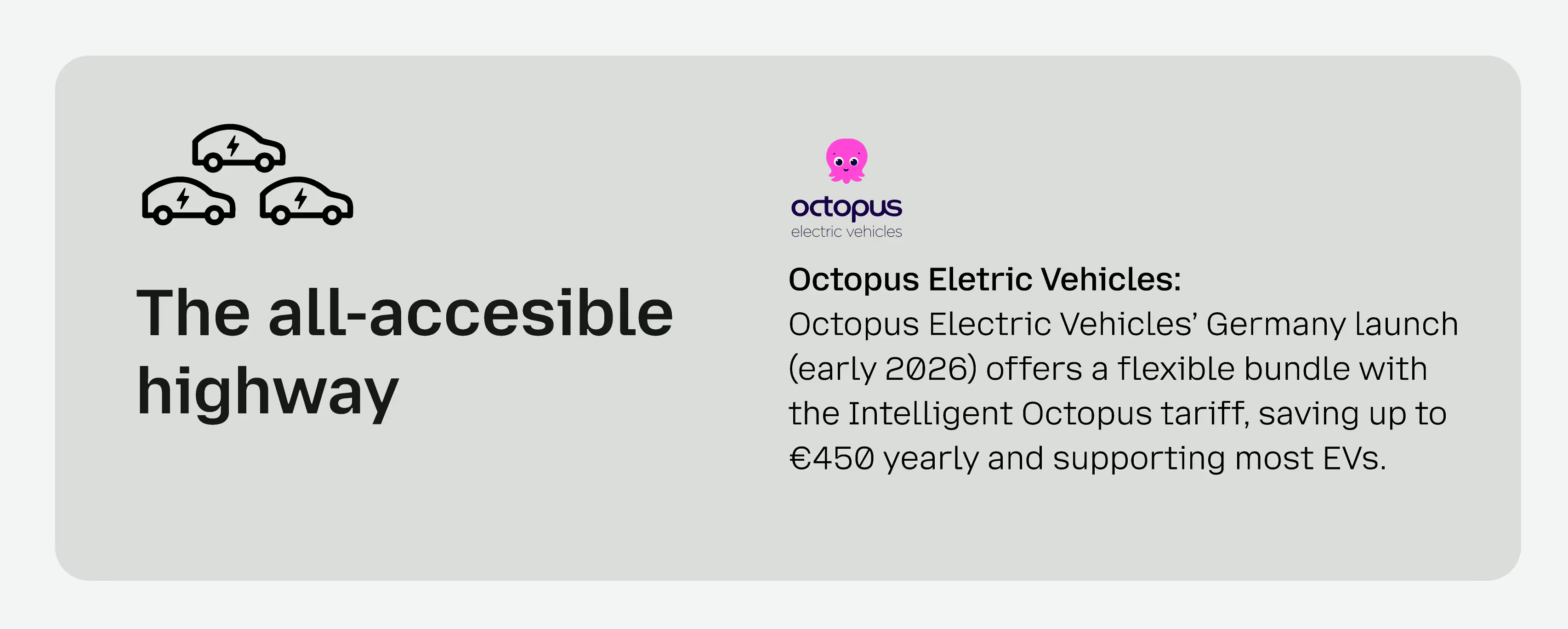The Smart Utilities’ Guide to V2G

Something brilliant is happening in car parks right now. Slowly but surely, electric vehicle (EV) are becoming the biggest, most flexible power plant in Europe. Millions of EVs are sitting dormant for 22+ hours a day, carrying a hidden reserve of grid capacity that utilities are barely tapping. Facts:
- The collective battery capacity of Europe’s EV fleet is on its way to reach 114 Terawatt-hours (TWh) by 2030
- EV batteries are set to exceed the total demand for new stationary battery storage for the entire EU grid by 2040. We’re talking huge grid buffers with zero additional grid hardware costs.
Yet, most utilities look at these vehicles as consumption loads, rather than batteries on wheels.
But things are changing. The technology is proving robust, customers are buying in and we finally see regulatory frameworks catching up, with initiatives like the EU Data Act facilitating data sharing for smarter grid integration.
Even the most conservative V2G growth projections make for mouth watering opportunity.
Plugging the X in V2X
Let’s start by getting the fundamental differences between the terminology right:
The three winding roads to V2G value
The narrow Italian street
Everyone knows narrow Italian streets. After scratching your mobilhome and spending the rest of your trip worrying about insurance, you realise these roads are only made for two-seaters.
In this strategy pairs, a utilities pairs with a specific EV manufacturer to offer seamless, integrated car-and-energy packages. The goal is to create smooth customer experiences and a fast speed-to-market through a "buy" strategy, leveraging pre-built solutions for faster rollout over full vertical integration. The downside is that this product only serves a limited part of the market.

The all-accessible highway
Here, you basically made an investment in both time and resources and put up a road for everyone to drive on.
This brand-agnostic model prioritises compatibility with any EV, maximising market reach and compatibility. Utilities that take this route focus on smart tech and are looking at lots of integrations.

The road that travels you
Here things take a turn. On this road, you’ll find car manufacturers offering both unidirectional charging (V1G) and bidirectional charging (V2G), enabling electric EV owners to feed back to the grid and earn, say, credits. Suddenly, the car manufacturer is in the driving seat and become neo-utilities, controlling the customer relationship and bypassing traditional utilities. Saw that coming?
If you would ask, we’d say that the ‘highway you built’ gets you farthest. Give the people the power to choose from a long list of EVs and turn their downtime into earnings. But you don’t need to build such a highway all alone.

Cruising the business case
Step 1: Sharpen your strategic V2G position
Time to make up your mind. Which one of the three roads we explained in the previous section are you on?
Step 2: Get those successful pilots rolling
Cover your market reach using the 80/20 rule
Knock knock. Who’s there? Pareto.
Focus on 80% of the total reach with 20% of the effort. In terms of car brands in Europe, that means you should focus on Volkswagen Group, Tesla, BMW, Stellantis, Volvo, Audi, Renault and Mercedes - these cover majority of the European EV market.
Plug the value into the EV
An EV is a battery on wheels. This is why the same markets for static batteries work for EVs. Think about intraday and portfolio balancing as the secret sauce to ensure your V2G flexibility earns the biggest possible paycheck.
- 🇩🇪 Germany: Target intraday markets for up to €215k/MW/year
- 🇫🇷 France: Leverage policy measures and social leasing schemes while targeting capacity markets for winter security.
- 🇬🇧 UK: Participate in balancing mechanisms and frequency response services, where fast-responding assets get you premium prices.
Get your customers on board with clever contracts
💡 Customer behaviour insight: Unless you're targeting energy professionals at scale, your residential customers likely prefers predictable monthly credits over complex energy market participation exposure. Lead with simplicity in your first offers, and add sophistication through customer lifecycle management.
Step 3: Full throttle on rollout
Make sure your strategic vehicle does not fall apart when hitting the market.
What you absolutely need:
- Real-time EV connectivity (not just smart meter data)
- Aggregation platform with optimisation, portfolio balancing, trading and billing capabilities (This is where our customers like us coming in)
- A customer-facing app that can capture customer charging preferences (either use our white-label app or have your own. We like both equally much)
- Inverter data connectivity to get that sweet self-consumption right (for customers with PV solar installations)
- A customer support desk that is ready to handle a new wave of questions.
💡 Build vs. buy decision: If time to market matters, work with a solid platform like ours to save time and focus on customer relationships and innovation. We take pride in our product’s design, focusing on keeping the cost to serve to a minimum.
A few tips so you’re not running out of fuel
Your pilots will reveal critical realities that pay dividends in customer lifetime value:
Grid code harmonisation: Align your businesses with the maturity of your geographical market. We have found established V2G frameworks in the UK, The Netherlands and Germany. The EU Data Act further supports data sharing and easing integration.
Customer education: Invest early in addressing battery degradation concerns and grid participation benefits to boost engagement. An in-app Q&A is like a gift from heaven.
Understand technology readiness: Mercedes launches bidirectional charging in 2026 with the electric GLC, but many current EVs need OTA updates or hardware modifications for full V2G capability. Factor hardware readiness into your manufacturer partnership decisions. Reach out if you want to learn more!
Time to hit the road ⏰
Europe's V2G market is consolidating around proven models. Your strategic advantage lies in execution speed and market positioning, not in waiting for perfect technology readiness.

💡 Want to get into the details of V2G market opportunities? Connect with our team at Powernaut. Beyond goofy wordplay, we're helping utilities across Europe turn their flexibility ambitions into profitable reality.
Find out what Powernaut can do for your energy business.
Get to know us
Discover our demo
Onboard your first asset


